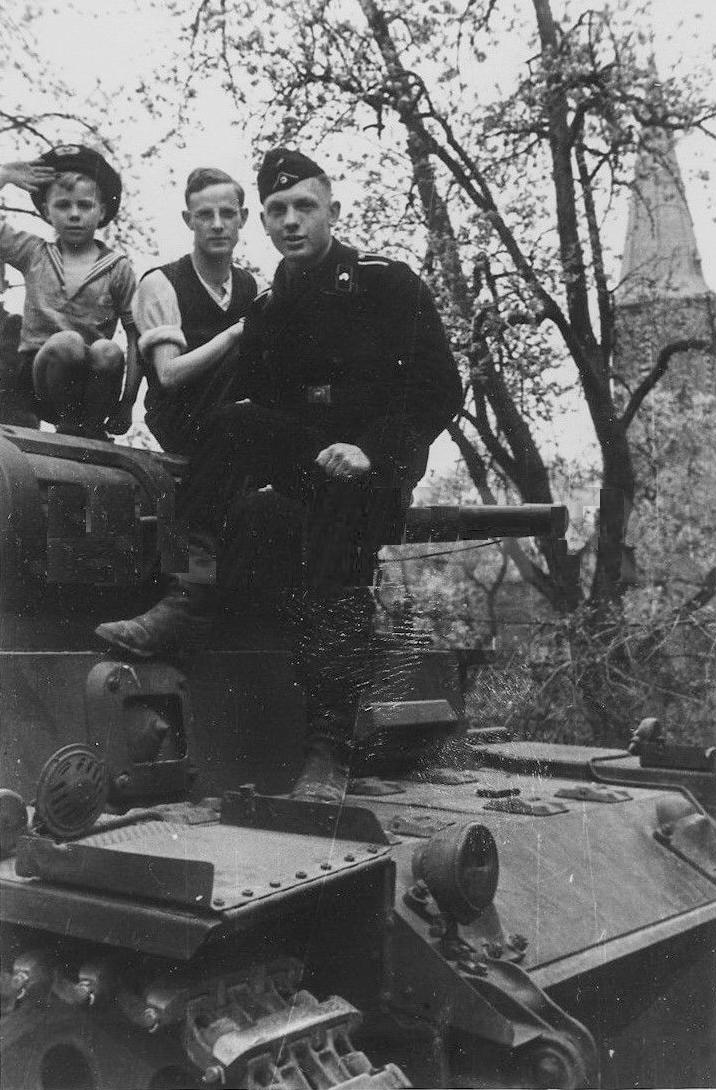
German World War II Tanks: The Crews

Figure 1.--You can see the price these German boys have with their brother in the Panzer corps. Notice the black uniform. The little boy giving the salute is wearing his brother's black beret worn while operating the tank. We are not sure, but this may be a Mark III with a small main gun. The earliest version had a 37mm then the next 2 versions had a 50mm and the final version had a 75mm gun. Notice the the Panzer Totenkopf collar patch. It was slightly different from that worn by the SS. The Panzer version had no lower jaw.
|
|
German Panzer crews spearheaded every major Whermacht campaign of World war Ii beginning with the invasions of Poland (September 1939) and most spectacularly apparent in the Western Offensive (May 1940) and Barbarossa (June 1941). This continued with the last great German offensive in the Ardennes (December 1944). The Panzer corps on every front of the War. They earned a formidable reputation for comptence and commitment in both offensive and defensive assignments. As far as we cal tell, Panzer crews were not a particularly select group, but rather chosen from the same pool as other Heer groups. It was not a volunteer group, but men assigned to the Panzers. We think this was a random selection, although heights may have been a factor. Hopefully readers will know more. The Panzer corps did, however develop a special Úlan and pride based on their impressive success in battle and contribution to the war effort. They had destinctive black uniforms and thus insrantly recognizable even when they were not with their tanks. The black uniforms were a practical choice. Black did not show the oil stains that were commonly associted with the tanks likevfield grey did. Tank commanders were chosen from Panzer crewmen who destinguished themselves in battle. The crew positions varied depending on the particular Panzer type. The mainstay of the German Panzer corps was the Mark IV which has five crew members. Three men (commander, gunner and loader were situated in the turreThis was heavilyemphasized in German newsreels. The driver and radio operator/bow gunner were situated un the forward hull. The training for these roles was specialized normally taking about 6 months. Each crew member usually qualified for at least two of these roles so the tank could be operated even if they sustaind casualties. Working together so closely, they also picked up on the various responsivilities.
CIH

Navigate the CIH World War II Pages:
[Return to Main World War II German tank page]
[Return to Main World War II country tank page]
[Return to Main World War II tank page]
[Return to Main World War II land technology/tactics weapons page]
[Return to Main World War II land technology/tactics page]
[Return to Main World War II technology/tactics page]
[Biographies]
[Campaigns]
[Children]
[Countries]
[Deciding factors]
[Diplomacy]
[Geo-political crisis]
[Economics]
[Home front]
[Intelligence]
[Resistance]
[Race]
[Refugees]
[Technology]
[Bibliographies]
[Contributions]
[FAQs]
[Images]
[Links]
[Registration]
[Tools]
[Return to Main World War II page]
[Return to Main war essay page]
Created: 7:01 AM 5/17/2014
Last updated: 7:01 AM 5/17/2014



